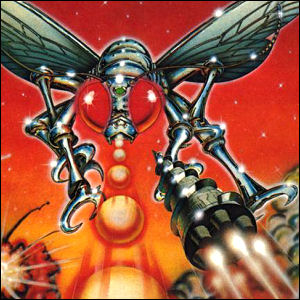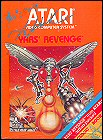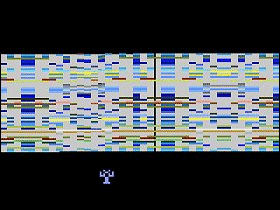 Atari releases the original title Yars’ Revenge for the Atari VCS home video game console. Despite not being a port of a popular arcade game (though it started out as an attempt to port Star Castle to the VCS), Yars’ Revenge sells well thanks for favorable reviews and good word-of-mouth. A pack-in comic from DC Comics, “Yars’ Revenge: The Qotile Ultimatum”, is included.
Atari releases the original title Yars’ Revenge for the Atari VCS home video game console. Despite not being a port of a popular arcade game (though it started out as an attempt to port Star Castle to the VCS), Yars’ Revenge sells well thanks for favorable reviews and good word-of-mouth. A pack-in comic from DC Comics, “Yars’ Revenge: The Qotile Ultimatum”, is included. ![]()
 The Game: As the last of a race of spacefaring insects, you must defend yourself from a relentless wave of alien attackers bent on ridding the universe of your race. An alien tracer, deadly to the touch, tracks your every move, though it cannot harm you while you’re in the neutral zone at the center of the screen. You must eat away at the aliens’ shield, which not only reduces their
The Game: As the last of a race of spacefaring insects, you must defend yourself from a relentless wave of alien attackers bent on ridding the universe of your race. An alien tracer, deadly to the touch, tracks your every move, though it cannot harm you while you’re in the neutral zone at the center of the screen. You must eat away at the aliens’ shield, which not only reduces their  defenses, but builds your energy reserve so you can fire your own powerful weapon, which can wipe out the alien, the tracer – or yourself, if you’re clumsy enough to be caught in its path. (Atari, 1981)
defenses, but builds your energy reserve so you can fire your own powerful weapon, which can wipe out the alien, the tracer – or yourself, if you’re clumsy enough to be caught in its path. (Atari, 1981)
Memories: One of the coolest games ever conceived for the Atari 2600, Yars’ Revenge was a brilliant arcade-style game. In fact, I’m amazed that it apparently never made it into coin-op form (like such games as Lode Runner and Pitfall!). In fact, Yars actually started out as an arcade port – though in the end, it differed significantly enough from its inspiration (Star Castle) that it was a whole new game.


Addictive, fast moving, and visually abstract and interesting in a way that took advantage of the Atari 2600’s limited graphical capabilities, Yars’ Revenge was a very cool game. Where the Atari 2600 version of Pac-Man is often a reminder of the 2600’s worst properties, Yars’ Revenge can be held up as an example of one of the best games that graced that machine. Programmer Howard Scott Warshaw has since moved into the video production field, producing his own documentary about his days at Atari, Once Upon Atari.
A Phosphor Dot Fossil examined by Earl Green
